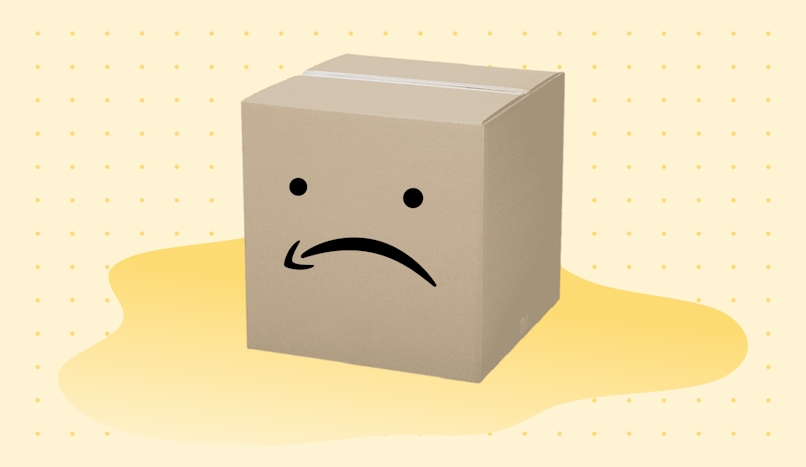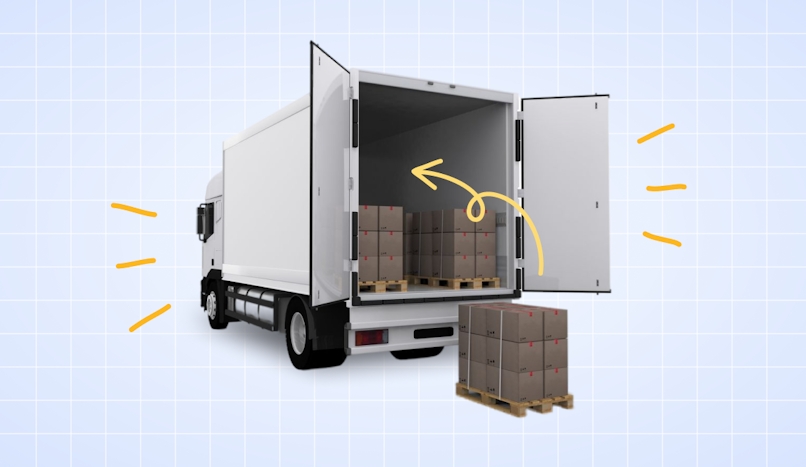How to Prevent Shipping Damage for Drivers: 4 Easy Ways With Examples
Shipping fragile or breakable items needs extra care. These four tips will help you prevent shipping damage and make sure your freight arrives in perfect condition.

Shipping damage happens. But, if you’re a delivery driver, you must constantly fight against it.
Today, shipping damage is an unfortunate reality that can cost you time and money.
As a delivery driver, it’s your responsibility to deliver packages safely. But some couriers don’t prepare for the worst: stacking your trailer insecurely, packing boxes without a strategy, and erratic driving will all increase your chances of package damage.
Customer expectations are increasing as well.
Today’s customers expect to receive the same pristine package that left the warehouse, whether the product inside arrives damaged or not.
How do you give your customers what they want and deliver a better experience? With careful planning before you set out on your route.
If you take these simple steps to load your freight properly, your drive can be slower and easier, knowing that you’ve minimized the risk to the goods under your watch. These methods are your best defense when accidents happen.
This is part of a series of posts from Pete the Courier Driver with hints and tips for other delivery drivers. Check out this guide if you want to know the best vehicles for the job.
What is shipping damage?
Here is one thing I always tell other delivery drivers, “The truth of the matter is, once it's on board, it's your problem.” If you are in charge of the car, you are in charge of the cargo.
Consumer protection laws on both the federal and state level usually place damaged goods under the responsibility of the retailer, not the consumer. Until goods reach the buyer’s custody, the business must uphold the promise to deliver that product as advertised.
Since you make deliveries on behalf of the retailer, delivery drivers like you and I take on some of that responsibility.
The way this usually works for drivers is through obligations in their contracts. When shipping damage occurs, you will be held liable for anything you neglected in your contract. In other words, you agree to use specific methods to make sure the packages are safe. If you fail to uphold those standards, you expect to bear that responsibility.
According to the Bureau of Transportation Statistics, highway transportation sees around 14,000 to 16,000 incidents related to property damage and hazardous materials. These in-transit issues lead to tens of millions in property damage.
Each year, only a few hundred of those thousands of incidents are accident-related. Most of these problems happen on the road or during loading and unloading procedures.
It isn’t those most extreme scenarios that cause so many damaged goods. It’s for seemingly insignificant reasons that cause so much money to be lost.
Issues like internal impact, scratches, stacking damage, and stress to boxes can all seem like unforeseen problems. However, those uncommon situations can damage the reputation of companies just as much as the items themselves incur harm.
Though significant damage is rare, those few instances can stick out far more than the countless perfect runs you may have had up to that point.
So instead of taking your chances, you can actively fight against the risk of shipping damage by addressing the common causes with my tips below. We say “better safe than sorry” for good reason when dealing with damaged goods. The consequences may cause more impact than just broken glass or a dinged-up box.
Common causes of shipping damages
There are a few ways that packages get damaged during transit. You should address each one of these areas before every job. Preventing problems here will give you peace of mind during your route.
While the possibility of shipping damage can vary between jobs, these are the most common reasons your packages will have shipping damage:
- Poor packaging that may fall apart or is not structurally sound
- Improper handling of goods, such as those that are fragile or oversized
- Poor loading style, including the organization of your vehicle
Unfortunately, there are many ways this type of damage can occur.
The most common issues are boxes with too much space, gaps for moisture to sneak in, or inadequate sealing. Treating every package as fragile can help to minimize further damage from insufficient packaging.
Liability for shipping damage

Since cargo will always need to change hands several times, there are many opportunities for packages to get mistreated. The obvious bad habits include throwing, squeezing, or shaking boxes during loading or transit. You can never count on a package withstanding that kind of treatment during transit.
Drivers should also be aware that losses can vary based on the extent of the damage. Damage claims can be divided into four categories:
- Apparent damage
- Incomplete shipment
- Hidden damage
- Lost items
Bottom-line, whether your packages are delivered with partial or irreparable damage, you are responsible for their condition during transportation as the driver.
The realities of shipping damages are an unfortunate part of the job. I find that it works out best when I take full responsibility for my part of the delivery. If I can prevent losses like this, I will gain customer satisfaction and increase their trust in our courier service.
4 tips to prevent shipping damage
None of these tips are revolutionary. However, if you ignore any one of these practices, you may increase the risk of shipping damage somewhere down the line. Paying attention to these simple suggestions can be the easiest way to avoid big headaches and loss of earnings.
#1 Identify fragile shipping labels
As obvious as this tip sounds, it never stops being true. If a package says that it’s fragile, treat it as such.
In fact, I tend to treat everything I transport like it’s a priceless antique. You’ll find that operating on the “safe side” throughout these tips is the best course of action.
You can use a few common-sense practices for the boxes that are clearly marked as fragile.
When you see red markings or bolded letters on a box, this tells you to handle the package with extra care. So, don’t toss those boxes or allow them any room to slide and topple. As much as you’d like to trust that the valuables are secured within the box, you should always go the extra mile and keep the package as still as possible in case internal items shift.
Another warning you see frequently is the yellow triangles or red labels meaning “do not stack.” Your best bet will be to pack those boxes near the top or keep them in a separate area. Remember that tightening straps over these fragile boxes can be dangerous, so always look for ways around the delicate areas.
Sometimes you can strap in the pallet from below if the boxes are attached securely to the frame. Other times you may need to apply different strategies so your cargo cannot budge. The packing advice below has some of my best ideas.
#2 Pack the truck correctly

One of the best pieces of advice I heard from a driver who was older and (slightly) wiser than me was to “let the vehicle pack for you.” This means that there are ways to make the loading process easier and the driving smoother by just paying attention to the structure of your rig.
One of the best ways to do this is to use the bulkhead as its own barrier for packages. When you put fragile boxes near this barrier, they won’t have any risk of moving except from side to side. This is a great way to secure boxes when transporting a smaller load or to take extra precautions with the riskiest items.
Distributing the weight evenly is another easy way to pay attention to your truck. I always try to put the heaviest packages near the back axles to balance my weight across the whole vehicle.
This method is all about using your resources wisely. It also helps to be very familiar with how your vehicle operates. Those more significant problems disappear when you load your freight like it should be loaded.
#3 Secure cargo properly
One of the biggest lessons to help prevent shipping damage is taking full responsibility for every package in your vehicle. Some people forget that this includes the touch points when you pick up and drop off the goods.
One of my buddies had to learn this the hard way. He let it slide that the distributors packed his pallets from lightest below to heaviest on top. Looking back, he should’ve said then and there, “no, that won’t cut it,” but he didn’t, so he transported packages that weren’t adequately secured, and the fragile bottles paid the price.
These principles of letting the boxes secure themselves are really important.
Always keep heavier things as the anchor below lighter boxes, especially when you’re handling fragile items. The other strategy I like is loading my boxes from largest to smallest. This way, you place the medium boxes between the big ones to create a natural space for the smallest ones.
Of course, you should always have your tools on hand to make this process smoother. Your shrink wrap will be a lifesaver in keeping your boxes held tight.
#4 Drive safely
Safe and steady driving might make more of a difference in preventing shipping damage than you think. Naturally, we want to avoid danger or accidents in our vehicles, but there are also plenty of benefits to driving safely that saves inventory, money, and headaches.
I always remind myself on the road to “keep it smooth” and maintain straight lines. When you keep up this mindset behind the wheel, you can minimize that side-to-side movement or abrupt stops that can cause the most damage to your cargo.
When cruising at high speeds, always leave a bubble of distance in front of you. Even if this needs you to slow down when cars weave in between, it’s worth taking some extra time. The key here is giving yourself plenty of room to brake slowly. This way, your packages can stay in place, and you never need to stop too quickly.
Statistics show that speeds as slow as 5 miles per hour can result in whiplash injuries if a vehicle brakes too abruptly. You wouldn’t want passengers in your car to lurch forward because you had to stop too soon, so leaving extra space will ease you to a stop without any problems.
The other area where smooth driving makes a big difference is on corners or roundabouts. Again, taking these spots slower will keep the whole vehicle straight and steady, minimizing internal movement. This may need patience as you navigate the turns with straight lines to avoid rocking side to side.
I think these extra precautions come naturally to me when I imagine that I’m transporting my family members. You'll see the value of going slower and gentler when you drive like you’ve got loved ones buckled in the back.

Tools to prevent shipping damage
Every vehicle needs tools to secure cargo: straps, blankets, corners, bubble wrap, and shrink wrap. I’ll tell you why these work and how I like to use them below.
Because when dealing with scenarios of accidents and damage, all you can do is prepare for the worst and hope for the best. You will be much better off in each job by having all these tools in your vehicle and ready to use. This way, your packages never budge during transit, and you have peace of mind along the way.
Straps to prevent shipping damage
Straps may seem self-explanatory, but I have made and seen a surprising amount of mistakes to cause more damage to boxes rather than prevent it. Pay attention to the markings on the box, which may tell you where not to apply pressure. If you’re loading pallets onto the truck, look for ways to strap down the pallet itself to avoid creating unnecessary strain on the boxes.
Blankets to prevent shipping damage
Blankets will help you when you need a smoother surface to slide heavy boxes in place. They also help to insulate between boxes and straps. Corner protectors can also help provide buffers between boxes, straps, and walls.
Packing around freight to prevent shipping damage
You may find that bubble wrap and shrink wrap is your best tool for securing cargo and preventing shipping damage.
Shrink wrap is perfect for keeping all your packages and pallets tight without the fear of crushing them as straps could. I believe that being generous with these two things can help all the boxes stay as a unit. That gives me more confidence to drive, knowing I’m not going to open up to an accident on the other side.
Shipping damage FAQs
Below, I’ve compiled some of the most common questions about how to prevent shipping damage.
How do I protect my shipment?
As a driver, you can find many precautionary measures to secure and protect your shipment throughout the delivery process. One method often overlooked is to speak with the teams who hand off the freight. They may have already solved loading issues you can use and pass along to the next courier.
Ultimately, you should exercise care and consideration during loading, driving, and unloading. Taking extra time to secure the packages and pack them to minimize movement will ensure that your drive goes smoothly and safely.
Who is responsible for shipping damage?
In most cases of in-transit damage, the supplier takes on responsibility. For example, a customer may choose to file a FedEx shipping damage claim. Based on the contract a courier signs with a retailer, they may assume specific responsibilities during the delivery process. Since the shipping process frequently requires contributions from several teams and couriers, cargo may encounter many opportunities for damage.
If obligations are neglected by the driver, such as careful handling and securing of packages, they may be liable for the damage that occurs under their supervision.
What do I do if packages are damaged?
If you notice or suspect damage to your freight during transportation, it is best to tell the customer of the package about any potential damages during handoff. Since filing and investigating a claim will take time, the most you can do after an accident is to be honest and transparent.
Plus, a courier service can create customer favor when drivers admit oversights and neglect. Though loss is always unfortunate, all parties can be happier when cooperating.
Conclusion: shipping damage
A prepared driver is an intelligent driver. When it comes to shipping damages, preparation might make all the difference. When you take extra time to secure your cargo and drive carefully, the little changes can avoid a big fiasco.
Our expert advice page has many other ways you can get prepared and drive smarter. If this page was helpful, let us know on YouTube or Facebook.



